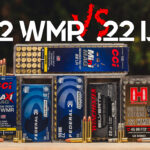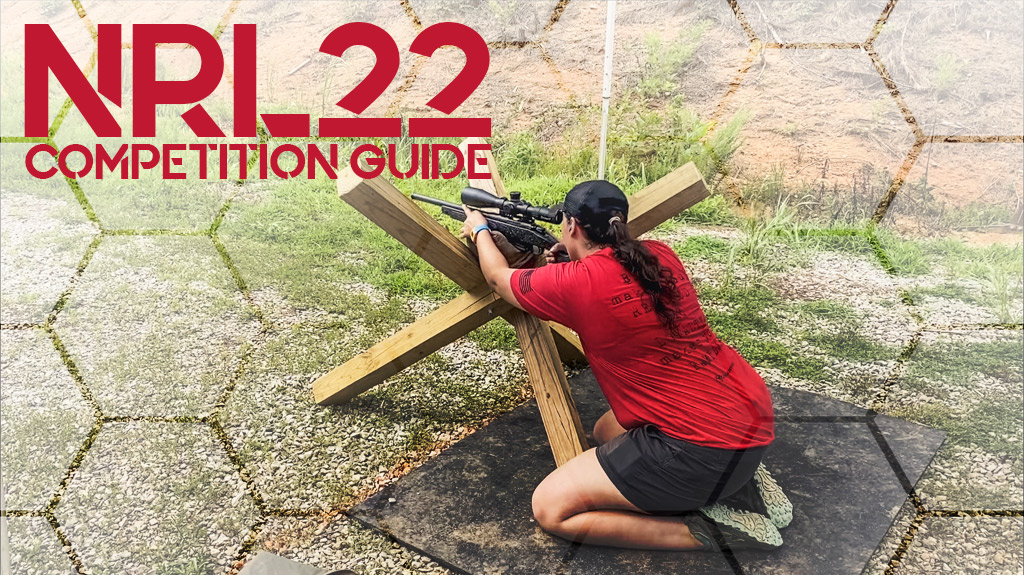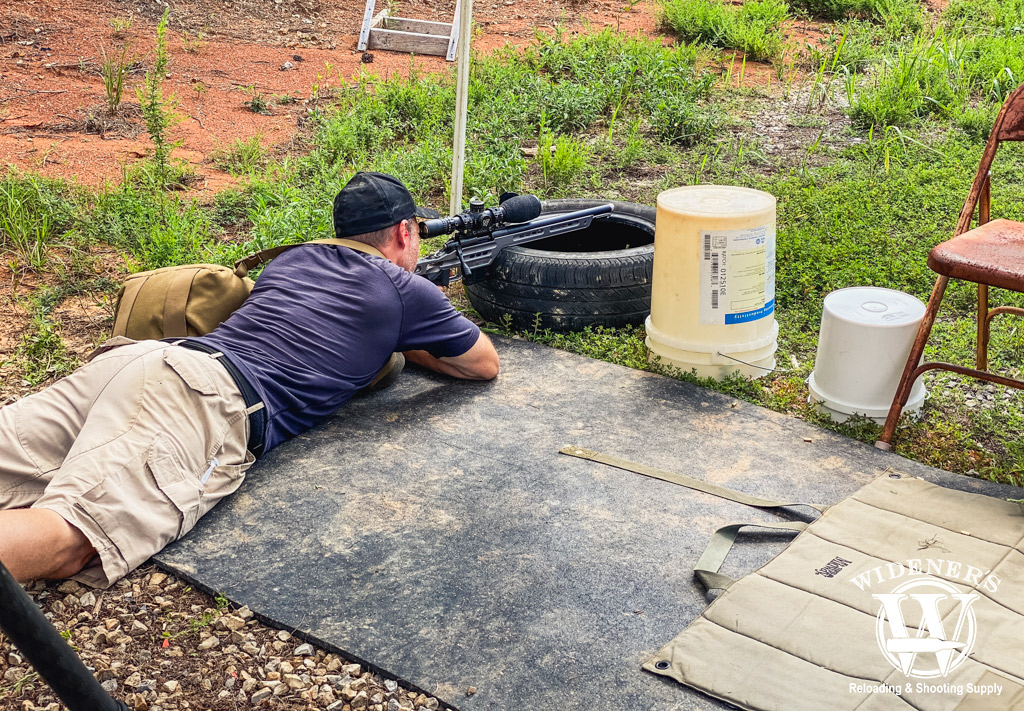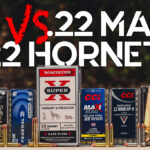

Guest Writer: Kenzie Fitzpatrick
One of the most fun action sports out there is the National Rifle League .22 competition or NRL22. The National Rifle League is an organization dedicated to the growth and education of long-range precision shooting. Whether this sounds fun to you or you want to dip your toe in the water before shooting Precision Rifle Series (PRS), NRL22 is a unique style of competition that is fun for all ages.
Competing: NRL22 Competition

NRL22 matches are a great place to start if you want to get into long-range precision shooting.
NRL22 matches can be run at any 100-yard range so members can participate in local competitions to qualify for regional and national championships. This drastically lowers the barrier to entry that a lot of ranges have for hosting Precision Rifle Series competitions.
Since the majority of ranges across America do not have 1000 yards to shoot across, NRL22 can be a way to find out if you enjoy shooting precision competitions before traveling to shoot competitions at a range that does have long-range distances available.
What is great about NRL22 is their organization provides a Steel Target Dimension Guide, a Standard Barricade List, a Monthly Course of Fire, and everything you need to promote and run a competition. Compared to other competitions where match directors have to create and build stages, NRL22 does all of the work for you, besides the physical match setup.
NRL22 Rules
No matter what shooting competition you decide to compete in, it is your responsibility to read the rule book before going to a competition. The NRL22 Rules and Regulations document is a great place to start before heading to a match.
One of the most obvious rules is that all rifles must be chambered in .22 Long Rifle. Magnum and like rimfire cartridges are not allowed. It is required that whatever rifle you choose has a removable magazine rather than a fixed, tubular magazine since it’s harder to make safe. Suppressors can also be used in these competitions.
If you plan to compete in Precision Rifle Series in the future, it’s a great idea to use a magnified rifle scope. I recommend one with externally adjustable turrets and reticles designed to assist in holdover and measurement so the transition is easier. However, any scope, iron, or electronic sights may be used in NRL22.
Something unique about NRL22 is that competitors may compete in Air Rifle, Young Guns, OG/Adaptive, or Ladies class with an air rifle (while meeting the other requirements for the class they plan to compete in).
Competition Class Divisions
Similar to Precision Rifle Series, NRL22 designed its classes to make it easy for newer shooters to compete without breaking the bank while also leveling the playing field. There are six classes, beginning with the base class which is budget-friendly and a great place to start. NRL22 classes include:
-
- Base
- Open
- Air Rifle
- Ladies
- Young Guns (8-16)
- Old Guns/Adaptive
Any rifle system that comes in under a combined MSRP of $1,500 shall be eligible to compete in the Base class. This combined MSRP price is for the rifle and scope only. It excludes scope rings and bases, bipods, suppressors, data cardholders, magazines, spare magazine holders, auto bolt releases, aftermarket triggers, and extended magazine releases. Adjustments are also allowed in this division as well as adding rails of any type.
Open-class shooters have no restrictions on the rifle. If any shooter goes over the MSRP amount of $1,500, they get bumped into open class.
Air Rifle class is for air gunners. If the shooter chooses to use domed pellets the Air Rifle must be a .30 caliber or lower. If the shooter chooses to use slugs, the Air Rifle must be a .25 caliber or lower and the slugs must weigh 45 grains or less. Projectiles must be mass-produced.
The Ladies’ class is for women shooters.
Age Specific Classes
A Young Gun is defined as any shooter between ages 8-16. A parent or guardian must be present with the shooter. The Young Gun competitor must be able to operate their firearm safely without any hands-on assistance. Verbal coaching is allowed and encouraged for Young Guns.
The OG/Adaptive class is available to any shooter older than 60 years old or any shooter that has special needs/considerations. The Match Director will determine the special needs and hold a meeting with all of the OG/Adaptive participants to discuss the course of fire and all agree on any changes/scaling to accommodate the OG/Adaptive class. An example would be utilizing a bench instead of shooting prone.
What About Equipment?

NRL22 matches use a variety of standard barricades including tires, ladders, and tank traps.
You can use any equipment in NRL22 unless a specific course of fire rules out using an item specifically. The only exception is tripods are never allowed. The sharing of equipment is allowed as well as slings to assist in unsupported positional shooting.
One of the best parts about shooting NRL22 is being able to use a variety of sizes, shapes, and weights when it comes to support bags. When you attend a local competition, ask fellow competitors if you can try their bags to see what you like and don’t like. It’s a good idea to grow your collection of bags so you can cater to specific courses of fire. When using a bipod on stages, you may consider buying a bipod that adjusts for height.
Choosing An NRL22 Rifle
Similar to how the world of PRS works, an NRL22 rifle is best when it’s a built gun vs. factory-bought. Remember too, you need to choose to compete in base class or open class, which will also help you choose your gun and scope according to the rules. I recommend building a chassis rifle. Specifically, one that is heavy, very similar to PRS as you want the rifle to rest well on props and barricades. In NRL22, you don’t have to worry about recoil management, but you do want a gun that balances well and that you can attach items to.
Building A Bolt-Action
If you want to build your own bolt action gun, for example, it’s a simple and fun process. You need to pick out an action, barrel, trigger, and chassis. Some companies that make chassis for the sport include Modular Driven Technologies or MDT, which is what I use, XLR chassis, if you’re into more wooden looks, WOOX makes a beautiful chassis. You also have Magpul, Manners, Boyds, and more. When it comes to barrels, you have options like Vudoo or Bartlein. Trigger options are endless from Triggertech to Timney triggers.
I invested in the MDT chassis you see here, and I actually purchased my barrel, action, and trigger from a friend of mine. While the barrel is a little short in terms of aesthetics, it works perfectly for me and was even a lot tested by Vudoo Gunworks with the Lapua ammunition that I prefer to run.
That being said, There are stock rifles that work well for this sport. Here’s a short list of stock rifles to get started with if you’re not ready to build your own. Consider the following (with appropriate divisions listed):
- CZ457, MSRP: $519 (Base)
- Ruger Precision Rimfire, MSRP: $619 (Base)
- Bergara B-14 R, MSRP: $1,129 (Base/Open)
- Volquartsen Summit, MSRP: $1,225 (Open)
- Vudoo Gunworks Apparition, MSRP: $2,600 (Open)
NRL22 Optics
For NRL22 scopes, you definitely want good clarity to see the smaller targets that will be at matches, but you don’t need as high of a magnification level as you would with the PRS sport. A rifle scope with a magnification range of 3-16X or 5-25X is typical. FFP is highly recommended with adjustable turrets and/or a ballistic reticle that allows holdovers.
I went with the Burris 5-25 scope which I think is decent at what I need it to do. A lot of shooters will run the Vortex 3-18, Athlon Argos 6-24, or Nightforce 7-35, to name a few. It’s really about what scope works best for you along with the reticle you feel most comfortable with.
You can join in the fun before going out and buying the most expensive guns and glass on the market.
Ammo Recommendations
Ammunition selection is crucial in NRL22. Since competitors can’t reload their own ammunition, they’re definitely at the mercy of manufacturers. There are a lot of options of .22LR ammunition, and some are much better for precision and accuracy than others. The best and most popular .22LR ammo used in matches are the Lapua Long Range 40gr, the SK Match 40gr, and Eley Match 40gr.
The way the ammo performs is also dependent on your barrel quality and length. Your gun might group better with one specific type of ammunition. If you find that magical recipe that works well for you, I recommend sticking with one brand and one ammo for your NRL22 shooting career.
Understanding Barricades
The best part of NRL22 in my opinion is that no matter what club you shoot a match at, you know what to expect because the standard barricades are all the same.
The standard barricades include:
- Up to three used tires 28-32”
- 6 Foot A-frame ladder
- 5-gallon bucket
- 2-gallon bucket
- 3 cylinder blocks 8”x8”x16”
- Open-back folding chair
- 55-gallon plastic drum
- Any 10ft length of rope
- Sawhorse with shelf on the bottom
- Tank trap (construction instructions provided)
Knowing what barricades you’ll be shooting off of can also help you know what to practice. If shooting off of a tire is difficult for you, go out and practice shooting off of a tire until it’s no longer your weakness. Figure out what bags work best with what barricades so when match time comes, you’ll be prepared to get into a good position.
How To Shoot An NRL22 Match

You don’t have to be an NRL member to shoot most club matches, get out there and have a great time!
Depending on how far your range can shoot out to, the National Rifle League provides two options for courses of fire; one with shorter distances and smaller targets, and a second option for longer distances, but with larger targets.
The steel target dimensions range from .25 inches wide to 6 inches wide. While this might seem small for newer shooters, it is preparing you for shooting larger rifle targets out to 1,000 yards and beyond, which will comparatively look or seem this small at distance.
Each course of fire will have a start position, including a description of the course of fire including any notes. You’ll also find an OG/Adaptive recommendation. There is no need for a range finder in NRL22 as all of the distances per course of fire are given to you. Some stages will require 10 rounds to be shot, while others may have you shoot 12 rounds. This could mean having to reload your rifle during a course of fire.
Each course of fire will also tell you the maximum number of points that are possible as well as how many points you can receive per impact. Courses of fire can also require weak side shooting and will designate that in the instructions.
Timing Is Everything
Each course of fire will have a set amount of time you can shoot the stage in. Most often, you’ll have 120 seconds to shoot a course of fire. Depending on your level of shooting, timing out on a stage before completing all of your shots is normal for a newer shooter. It sometimes happens to even more advanced shooters. There are so many variations of courses of fire. They really test a shooter’s ability to stay calm, make accurate shots, get into a good position, and remember instructions.
No matter what course of fire you are shooting, bolt action rifles should always have the action open. Semi-automatic rifles should have the safety engaged when moving from one barricade to another. Always show clear at the end of a stage and use an empty chamber indicator (ECI) or mag block flag. One pro tip is using a weedeater plastic string as an ECI.
Register For NRL22 Matches
Find a club near you or search Practiscore for NRL22 competitions. You don’t have to be an NRL22 member to shoot most club matches, but signing up as a member has its perks! The National Rifle League sends a swag bag to members. It also has raffles, give-aways and provides discount codes to members from sponsors. Members can participate in all NRL22 and NRL22X matches, and be ranked/scored nationwide.
NRL22 is more challenging than you think. Go into your first competition with an open mind and don’t get discouraged if you time out on stages. Focus on getting into a good position and the hits will come. Once you’ve mastered the art of shooting NRL22, consider getting into the Precision Rifle Series.
*Editor’s note: The rules listed in the article have been updated to reflect the 2024-2025 guidelines put out by the National Rifle League.


